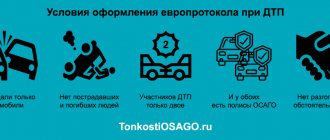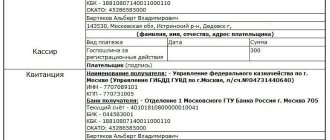What is depreciation?
Depreciation according to OSAGO is the depreciation of vehicle spare parts received during its operation. This parameter is used by insurers to reduce payments under insurance policies and is legal. The thing is that in the event of an accident, most of the car’s spare parts are not new, which means that their market value before the accident is lower than that of a new car (read about how to calculate the cost of spare parts according to compulsory motor liability insurance on the RSA website). As a result, when calculating the insurance payment, insurers do not pay 100% of the average market value of the part, but somewhat less.
In what cases is it necessary
After concluding a contract for compulsory car insurance, the car owner has the opportunity to receive compensation in the event of an insured event.
Insured events include the following situations:
- the collision occurred between two cars, one of which was moving;
- the victim and the perpetrator are identified;
- Both sides have valid motor vehicle licenses.
Car repairs under MTPL will not be carried out if:
- the insurance policy specifies a vehicle that was not involved in the accident;
- a collision of motor vehicles occurred as a result of testing, competitions or training driving;
- The driver who caused the collision applies for compensation;
- damage to the vehicle was caused by cargo requiring separate insurance or during loading/unloading of goods.
Thus, vehicle repairs are carried out only upon the occurrence of an insured event, confirmed by documents.
Legislative regulation for insurance companies
The legality and legality of wear and tear under compulsory motor liability insurance is regulated by two legislative documents:
- Article No. 12 of Federal Law No. 40, as amended in 2017, which introduces the concept of mandatory “motor citizenship”.
- Chapter No. 9 of Government Resolution No. 263, which regulates compulsory car insurance. The amount of accrued depreciation is regulated by another document: Appendix of the Central Bank of Russia No. 432-P. This document was adopted in 2014. The described method of calculating depreciation under MTPL is mandatory for use by insurers, their employees and independent expert appraisers.
How and by whom is it considered?
A legal calculation of depreciation under compulsory motor liability insurance, which has legal force, can only be data obtained from a certified expert agency, with which the insurance company must necessarily enter into an agreement.
At the same time, you need to understand that in the vast majority of cases, the insurer does not turn to the services of such agencies and calculates depreciation independently. This is not illegal if the insurance company does not issue an official opinion on this issue, but only uses an independent calculation to determine the amount of insurance compensation.
What is better to choose money or repair
So, after the occurrence of an insured event and the execution of all relevant documents, the car owner is faced with choosing a method of receiving compensation.
What is better: money or repairs under compulsory motor liability insurance? To understand this issue, it is necessary to find out the negative and positive aspects of each method of obtaining compensation.
The advantages of monetary compensation include:
- reduced time frames for obtaining compensation for damages. 20 days are allotted to assess and make a decision to recognize the situation as an insured event;
If the policyholder chooses money instead of repairs, then after this time the compensation amount will be transferred to the victim’s bank account. To carry out restoration repairs of vehicles, additional time will be required (repairs can be carried out within a period of up to 35 days).
- the ability to independently select an organization that will subsequently restore the damaged car;
- the ability to independently perform a number of works to restore the vehicle;
- the ability to determine which work needs to be completed at the moment and which can be postponed.
The disadvantages of monetary compensation are:
- the need to independently select a repair organization and agree on the list of work performed, which requires some time;
- after receiving compensation, the vehicle remains unrepaired, which makes it impossible to operate;
- insufficient funds to fully restore vehicles. The amount of compensation is calculated taking into account the wear and tear of the main components of the vehicle;
- completion of a case with an insurance company for a specific insured event.
After payment of compensation in cash, it is considered that the insurance company has fully fulfilled its obligations under the insurance contract.
Restoration repairs, as a way to receive insurance compensation, have the following positive aspects:
- The car owner does not have to worry about car repairs on his own. This function is performed entirely by the insurer;
- restoration of vehicles is carried out in a short time, since all parties are interested in this.
Negative features of repair include:
- limited choice of organization for repairs. The insurance company enters into contracts for vehicle repairs with a certain range of companies and the policyholder must select repairmen from the list provided;
Very often, the repair organizations presented to choose from do not have the necessary qualifications, equipment, etc. for repairs, which affects the quality of the work performed.
- the car owner does not receive any money. An agreement is concluded between the insurance company and the repair organization for the restoration of the car and the funds after the repair are transferred directly to the account of the company that performed the work;
- the owner of the vehicle is not able to monitor the progress of repairs.
Thus, each method of insurance compensation has its own advantages and disadvantages. Each car owner has the right to independently choose which method is best for him.
Formula and coefficients
The depreciation of car parts under compulsory motor liability insurance can be calculated independently or using online calculators to calculate insurance payments, taking into account the percentage of depreciation. Each of these methods will be discussed below. So, in order to calculate depreciation on a vehicle license using an online calculator, you will need to enter the following data:
- vehicle release date;
- date when the accident occurred;
- type of vehicle;
- vehicle mileage as of the date of the traffic accident;
- Tire tread height on the date of the accident.
By entering all the above data, you can get the total wear of car parts, wear of the car battery and wear of tires. To calculate the wear and tear of a car yourself, you will have to use the formula that is determined by the unified calculation system established by the Central Bank of Russia.
To calculate wear, you need to raise 2.72 to a power, the value of which is equal to - (ΔT*Tki+ΔL*Lki), where:
- ΔT – coefficient determined by the service life of the machine.
- Tki – years during which the car was operated.
- ΔL – coefficient determined by the vehicle mileage.
- Lki – kilometers traveled by the car.
The resulting value must be subtracted from 1 and multiplied by 100 .
The resulting value will show the wear of parts as a percentage.
The parameters ΔТ and ΔL deserve special attention. Their values must be determined from the table below.
| Type of vehicle | ΔT value | ΔL value |
| VAZ, UAZ, GAZ, TagAZ, ZAZ | 0,057 | 0,003 |
| Brilliance, BYD, Chery, Derways, FAW, Geely, Great Wall, Hafei, Haima, Lifan, Luxgen, Xin Kai | 0,057 | 0,0029 |
| Aston Martin, Bentley, Bugatti, Ferrari, Jaguar, Maserati, Porsche, Audi, BMW, Mercedes-Benz, Mini, Rover Alfa Romeo, Citroen, Fiat, Ford, Opel, Peugeot, Renault, Saab, SEAT, Skoda, Volkswagen, Volvo | 0,042 | 0,0023 |
| Acura, Buick, Cadillac, Chevrolet, Chrysler, Dodge, Hummer, Infiniti, Jeep, Lexus, Lincoln, Mercury, Pontiac | 0,045 | 0,0024 |
| Daewoo, Hyundai, Kia, Ssang Yong, | 0,052 | 0,0026 |
| Toyota, Mitsubishi, Daihatsu, Honda, Isuzu, Mazda, Nissan, Subaru, Suzuki, | 0,049 | 0,0025 |
| Freight vehicles | 0,077 | 0,0023 |
| Buses | 0,113 | 0,0008 |
| Trolleybuses and trams | 0,098 | 0,0008 |
| Trailers for trucks | 0,09 | 0 |
| Trailers for cars | 0,06 | 0 |
| Motorcycles | 0,07 | 0 |
| Agricultural, fire, construction and other special equipment | 0,15 | 0 |
The full formula for calculating compulsory motor liability insurance and a table of all coefficients can be found in this material.
Which car parts are subject to accrual and which are not?
Depreciation under compulsory motor liability insurance is charged on all vehicle spare parts, except for the list specified by law. This list includes the following:
- Airbags for driver and passengers.
- The seat belt and all its components.
- Components and assemblies of pneumatic, electronic-pneumatic and hydraulic brake systems.
- Steering wheel control components and assemblies.
- Components and assemblies of the vehicle clutch system.
What to do if the insurance company underestimates payments?
Cases where insurers overestimate the wear and tear of parts are not uncommon. This is due to the fact that the goal of any player in the insurance market is to make a profit , whatever they say in their advertising. Unfortunately, practice shows that in negotiations with the policyholder, the insurer does not accept arguments regarding the incorrect calculation of wear and tear. The only option left to the policyholder is to go to court.
But there is one serious pitfall: the lawsuit will have to be accompanied by a conclusion from a certified company that is allowed to conduct such examinations, and these are additional costs, which, if won, will fall on the shoulders of the insurance company, and if the claim is not satisfied, will remain additional costs for the insured.
Please note: After filing an application with the court, a hearing will be scheduled at which the judge, after listening to the opinions of the parties, will order a third examination at the Chamber of Commerce and Industry or a similar government agency.
It is on the basis of the conclusions of these experts that a verdict will be rendered on the claim for review of wear and tear under OSAGO. In general, depreciation under compulsory motor liability insurance is a variable that has an exact calculation formula, which does not prevent insurers from trying to deceive policyholders by overstating depreciation or applying it to parts to which it cannot be applied by law.
Therefore, every vehicle owner needs to understand the depreciation formula so that he can check the correctness of the calculation of this variable and, if necessary, go to court to restore justice.
In order to be sure of the correct calculation of insurance and payments for it, we suggest that you familiarize yourself with the following information:
- tariffs for compulsory motor liability insurance and its calculation;
- how to calculate an electronic MTPL policy using an online calculator;
- driver class and its impact on the cost of insurance;
- how to calculate the loss of marketable value of a car;
- how to calculate the amount of payment under compulsory motor liability insurance in case of an accident;
- how to calculate damage using the RCA database.
Law on wear and tear of vehicles under compulsory motor liability insurance
Depreciation for compulsory motor liability insurance is discussed in the “Insurance Rules”, which were approved by the Central Bank of Russia. In particular, it says the following: “The insurance company, when determining the amount of costs for restoring a car, is obliged to take into account the wear and tear of parts, mechanisms, electrical equipment and other elements of the car. The amount of expenses for spare parts should be established taking into account the wear and tear of components that are subject to replacement during the process of restoration and repair work. Moreover, component parts cannot be subject to depreciation of more than 50% of their original cost.
Related article: E-OSAGO policy for a car and what it should look like










